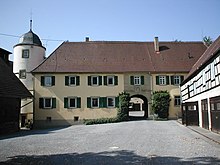Philip the Wise of Gemmingen
Philip the Wise of Gemmingen (* 1518 ; † 1571 in Böhringsweiler ) came from the II line (Gemmingen and Guttenberg) of the barons of Gemmingen . He was a bailiff in Neuburg and Amberg and stood by several princes as advice. He received his nickname of the sage not least because of his mathematical talent. He owned a large library, which was also rich in mathematical instruments and globes. He built a moated castle in Bonfeld and received market rights for the place in 1570 .
Life
He was the son of Dietrich von Gemmingen († 1526) and Ursula von Nippenburg. Philipp was mathematically gifted, his tutor was Kaspar Gräter . 1533 enrolled him at the University of Heidelberg . In 1535 he lent the city of Esslingen 2,300 guilders. In 1539 he sealed the comparison between the community of Haßmersheim and its pastor because of a disputed tithe . In 1540 he was chairman of the Palatinate court. In 1545 he was one of the prescribed collectors of the Turkish tax . For his assistance to the outlawed Johann Friedrich von Sachsen and Landgrave Philipp von Hessen in the Schmalkaldic War he was called to account by Emperor Charles V in 1548 and had to pay a fine of 4,000 guilders. In 1549 he took part in a man fief court in Speyer. In 1550 he had an epitaph built for his parents at Guttenberg Castle. In 1556 he took part in the funeral for Count Palatine Friedrich II with four horses . In 1557 he was a delegate to the Reichstag in Regensburg. In 1563 he was sent to the elector by the Lutheran princes Karl II of Baden, Christoph von Württemberg and Wolfgang von Pfalz-Zweibrücken, together with the Württemberg vice-chancellor Hieronymus Gebhard , to negotiate with him about the examination of the Heidelberg catechism by the imperial estates.
In later years he had his residence in Bonfeld . There he had a renaissance castle built from 1564 to 1568 below the "old castle". The castle was also called the "lower castle". On June 16, 1570, Emperor Maximilian II stopped in Bonfeld on his way to the Reichstag in Speyer. The outside of the castle was already finished, but not yet fully furnished. The emperor was entertained in a tent in front of the castle, in the castle the nobles of the area gathered and drinks were prepared. A few weeks later, Emperor Maximilian granted Bonfeld market rights. To commemorate the emperor's stay, Philipp had a stone column erected at the place of the tent, remains of which are still in the Eichhauser courtyard today . Philipps Castle was later opened in the Meiereihof between the Upper Castle and the Lower Castle ; the most important structural remnant is the stair tower. In one of the farm buildings, an old lintel with the date 1568 is walled up.
He owned a large library with a focus on mathematics and astronomy , which in addition to books also included mathematical instruments and globes. After his death, the library was probably divided. The son Weyrich inherited a part and so part of the library with his inheritance came to Pleikard von Gemmingen zu Fürfeld. The library was completely lost in the Thirty Years War .
As the advice of Duke Ludwig, Philipp von Gemmingen received the hunting lodge in Böhringsweiler as a salary , where he died in 1571. He was buried in Bonfeld.
family
His first marriage was to Margaretha von Vellberg. The daughter Amalia, who died early, came from this marriage. He went into a second marriage with Katharina von Gemmingen-Michelfeld († 1583), the daughter of Michelfelder landlord Weirich von Gemmingen (1493-1548). This was considered a "pretty Kätherle", but in old age she got a not very pretty beard, which she hid under a veil.
Progeny:
- Amalia († 1549 at the age of 7)
- Weyrich (1552–1574)
Individual evidence
literature
- Carl Wilhelm Friedrich Ludwig Stocker : Family Chronicle of the Barons of Gemmingen , Heidelberg 1895, pp. 60–64.
- Rudolf Petzold: Bonfeld and the barons of Gemmingen-Guttenberg (1476-1806) . In: Heimatbuch Bonfeld , City of Bad Rappenau 2000
Web links
- Biblioteca Apostolica Vaticana, Pal. lat. 1920: Catalog of the Fugger library and the library of Philipps von Gemmingen at https://digi.ub.uni-heidelberg.de/
| personal data | |
|---|---|
| SURNAME | Gemmingen, Philip the Wise of |
| BRIEF DESCRIPTION | Bailiff in Neuburg and Amberg |
| DATE OF BIRTH | 1518 |
| DATE OF DEATH | 1571 |
| Place of death | Boehringsweiler |
